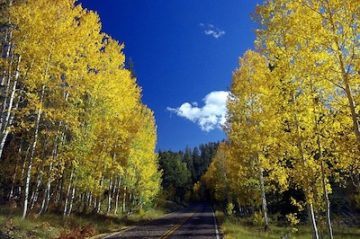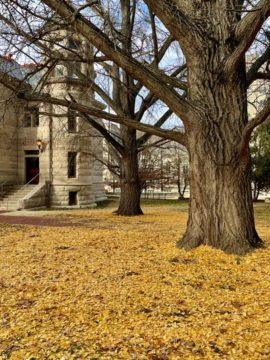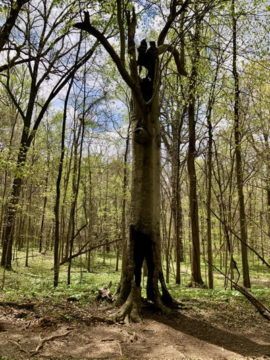by Mary Hrovat

When the city of Melbourne set up email addresses for trees so that people could report problems, the trees received affectionate fan mail as well as messages about dangling limbs or other hazards. Here are some letters I’d write to trees, if I could.
To the aspens in Hannagan Meadow
I saw you in fall 1979; I’d been married to my first husband for only a few months. We traveled a lot that fall, scouting out places we might like to live out our back-to-the-land dreams and raise a family.
I was only 18, and I’d never lived in the country. I wasn’t sure I was ready for life with cows and chickens and a big garden. Sometimes, especially when we were driving at night through what seemed like the lonelier corners of Arizona, I was frightened at what I’d gotten myself into. Maybe my husband and I both were, but we couldn’t tell each other.
When I saw you, we were halfway up the Coronado Trail Scenic Byway from Clifton to Springerville, in eastern Arizona. This highway covers only 129 miles, but it’s a slow, dramatic drive, up and down through the White Mountains along curves and switchbacks.
We stopped at Hannagan Meadow for a break. You were probably the first stand of aspens I’d seen in fall colors, tall and slender with yellow leaves against beautiful white bark. I loved your brilliance and the movement of your glowing leaves against a more somber backdrop of tall evergreens. I didn’t know much about aspens, but I wonder now if all of you, the aspens I saw that day, are part of a single clonal community.
The sight of you in that meadow, tall and bright in the sunshine, dazzled and comforted me. You called me out of myself and my worries. Among all the beautiful things I saw that fall, you’re the one that has remained most vivid in my memory. I hope you’re still there. I’d like to see you again someday.
To the hedge apple tree in a long-ago yard
I’d never heard of a hedge apple before I moved to Indiana, and I hadn’t heard of you by your other name, Osage orange, either. You stood outside the first house I lived in here. You were probably the first tree I paid attention to in my new home. I could see you from the kitchen window every day when I washed the dishes.
We learned early on that you had thorns. You stood near a path that came up from the driveway and around to the front of the house, and we discovered low thorny limbs that tended to catch on clothing or skin if we weren’t careful.
Later I learned what a hedge apple was. I’d never seen anything like them. Even the birds didn’t seem interested in your large rough fruits, oddly textured and resembling green brains. Children liked them, though. There was a school bus stop at our corner, and kids would stand at the edge of our lawn and throw hedge apples at the street light pole and possibly each other. I have to say that between the thorns and the weird fruit, I didn’t appreciate you all that much at first.
I’ve since learned that you’re a member of the native North American species Maclura pomifera, and you’re related to mulberry trees (you have nothing to do with apples or oranges). Your species apparently outlived whatever animal ate those large fruits and spread your seeds, although squirrels sometimes eat your seeds now. Your wood is desirable for its strength and flexibility, and, as we might have guessed from the thorns, you can be planted densely to form nearly impassable hedges. I remember you, though, not for any utility to humans or other animals but for what you taught me.
It took me a while to learn the trees of Indiana, and even longer to really see trees in winter. Notable seasonal changes were one of the things I came to the midwest for, but once the colorful outburst of autumn was over, I had no eye for trees. It was years before I started noticing how the character of individual trees becomes visible in winter.
You gave me my first clue. One night during the second winter in that house, I got up to feed the baby and found that it had snowed. I stopped for a moment at the kitchen window to look at you. Your wet branches were dark and outlined in fresh snow, which caused me to notice their shapes. Instead of looking past you, I looked at you. For some reason that was a memorable moment: the baby, the quiet night, the snow, my cold feet on the floor, and the unexpected particularity of a living thing that had been largely background. I’m grateful you were there, thorns and all.
To the two big ginkgo trees on the IU Bloomington campus

From my limited perspective, you’ve always been here. You were planted in 1895 and had grown large and majestic well before I first saw campus. You predate most of the buildings on campus, including my favorite part of the Old Crescent, Kirkwood Observatory, which was completed in 1900. I’ve walked by you countless times over the years, beginning when I was a student in the 1980s. For the past 23 years, I’ve lived on or near campus, and I usually see you several times a week. You’re a familiar and beautiful presence.
The advice these days is to plant male ginkgo trees in public spaces because in autumn, the females produce seeds with a pungent outer layer. You were planted long before that advice became common, I would guess, and you’re both females. Sometimes when I walk by you, I hear someone telling a companion about the smell. On the plus side, you’re much less allergenic than males of your species.
You’re such glorious trees that it seems to me the smell is well worth it. In addition to the size and grandeur of individual trees, Ginkgo biloba has a relatively long history. It was one of the first trees on Earth. They call you a living fossil because your species has changed so little over time. It’s the last surviving species in the family Ginkgoaceae; 250 million years ago, that family and conifers were the predominant trees on the planet. To put that into an astronomical perspective, it takes the sun about 230 million years to orbit the center of the Milky Way. You remind me of deep time.
You don’t have many pests or diseases, so maybe you’ll be here for another 127 years, or even much longer. The oldest ginkgo is reportedly 3500 years old. I hope you outlive me, anyway, because I’d grieve to see you go.
To the red maples along the path I used to take to work
Sometimes I would greet you when I walked by every day, if no one else was around to hear me. There are nine of you along the last part of the footpath I took to work for years. You’re relatively small human-scale trees. It’s easy to imagine you in a neat row like the lollipop trees of a child’s drawing, but of course that’s a human abstraction. No two of you are alike. You seem so compact and staunch and sturdy; I love the way your leaves, when they fall, make red circles at your feet.
You always seem to be the last trees to shed your leaves. I noticed this during the second autumn that I walked past you to and from work every day. My mother died that November, and I remember that you were stalwart in your red after most other trees were bare. You lost your leaves sometime after I flew to Phoenix to say goodby to Mom. I try to appreciate you, and all trees, for yourselves rather than your metaphorical value for humans. But when I returned after her funeral, your bare branches seemed to mark my loss. We were in tune.
To the hollow beech tree in Winslow Woods

Many years ago I lived not too far from you, and I used to walk in your woods, but I didn’t know you. Beech trees can live a long time; you were probably here then, a younger and perhaps more sound tree. A good friend introduced me to you a few years ago. I was fascinated to see that you still put out leaves in the spring.
I hadn’t really noticed before that hollow trees are alive and can still produce leaves. The first time I saw you, I thought about how much you’d lost, as if most of your living self had worn away. But recently I learned that even in a whole tree, much of the structure isn’t alive. Bark is dead phloem; heartwood is dead xylem. The sapwood, the outermost layer underneath the bark, is living wood that draws water from roots to leaves. You’ve lost some of your structure, but you’re pretty much as much alive as you ever were.
Again, I hesitate to apply human concepts to you. But I’m irresistibly drawn to an admittedly imperfect parallel here. I’m old enough to look at photos of people close to me and note who’s gone, not just from older generations but from my own. The thing about surviving to old age is that you can’t take everyone you ever loved with you. With increasing age, I risk losing more of the social structure that supports me, in something like the way your history, as embodied in your heartwood, supported you. This has occurred to me often since my sister died last year. I wish you could tell me: How does it feel to live on for years after you start to lose your heartwood?
###
I’m grateful to Julian Hook for sharing his photographs.
You can see more of my work at MaryHrovat.com.
